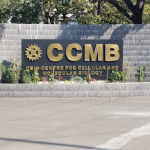सीएसआईआर - कोशिकीय एवं आणविक जीवविज्ञान केन्द्र
वैज्ञानिक तथा औद्योगिक अनुसंधान परिषद
भारत का नवप्रवर्तन इंजन
Date : सितम्बर 5, 2024

4th June, 2021: Banaras Hindu University (BHU), Varanasi and the CSIR-Centre for Cellular and Molecular Biology (CCMB), Hyderabad have collaboratively sequenced genomes of coronavirus variants in Varanasi and adjoining areas. Their study reports at least seven major strains of coronavirus circulating in these regions. The Multidisciplinary Research Unit headed at BHU collected samples from Varanasi and areas around the city, mostly in April 2021. The team at CCMB sequenced these samples and found out that there were at least seven major variants circulating in the region. 130 samples were sequenced in this study.
“Among the Variants of Concern (VoC), the most predominant variant we found in our study was B.1.617. This variant was also reported to be one of the major drivers of the second COVID-19 wave in India”, said Prof Singh, who heads the Multidisciplinary Research Unit at BHU.
“Just as in most of India, the B.1.617.2 variant (aka Delta variant) was the most common one in the samples we studied. They were found among 36% of the total samples. Other VoCs such as the B.1.351, detected in South Africa for the first time, was also found in this area”, said Dr Rakesh Mishra, Advisor, CCMB. “This study confirms yet again that the Delta variant is the most widespread coronavirus variant in the country right now. But at the same time, it is imperative for us to keep an eye on the other emerging variants in the country to prevent another unprecedented surge of cases”, he adds.
काशी �हंद �वश्व�वद्यालय ू (बीएचयू), वाराणसी और सीएसआईआर-सेललर और आण�वक ु जीव�व�ान क�द्र (सीसीएमबी), हैदराबाद ने वाराणसी और आसपास के �ेत्र� से कोरोनोवायरस वे�रएंट के जीनोम को सीक्व�स �कया है। इस अध्ययन म� पाया गया क� इस �ेत्र म� कम से कम कोरोनावायरस सात व�रय�ट्स उपिस्थत थे । बीएचयू क� एम आर य ् ू लैब ने वाराणसी और शहर के आसपास के �ेत्र� से ज्यादातर अप्रैल 2021 म� वायरस के नमने ू एक�त्रत �कए, सीसीएमबी क� ट�म ने इन नमन� को ू सीक्व�स �कया और पाया �क इस �ेत्र म� कम से कम सात प्रमख प्रकार ु प्रसा�रत हो रहे थे। इस अध्ययन म� 130 नमन� का ू सीक्व�स �कया गया।
” हमारे अध्ययन म� सबसे प्रमख ु वे�रएंट ऑफ़ कं सनर् (वीओसी) बी.1.617, िजसको डबल म्यु ट�ट कहा जाता है था। इस वे�रएंट को भारत म� दसर� ू COVID-19 लहर के प्रमख ु कारको म� से एक बताया गया था”, बीएचयू म� एम आर य ् ू लैब क� प्रमख ु प्रोफे सर �स ंह ने बताया।
“जैसा �क भारत के अ�धकांश जगह� पर बी.1.617.2 वे�रएंट (उफर् डेल्टा संस्करण) हमारे द्वारा अध्ययन �कए गए नमन� म ू � सवार्�धक था। वे कुल नमन� म ू � से 36 प्र�तशत म� पाए गए। अन्य वीओसी जैसे B.1.351, जो पहल� बार द��ण अफ्र�का म� पाया गया था, इस �ेत्र म� भी पाया गया”, डॉ राके श �मश्रा, सलाहकार, सीसी ऍम बी ने कहा। “यह अध्ययन �फर से पुिष्ट करता है �क डेल्टा संस्करण अभी देश म� सबसे व्यापक कोरोनावायरस वे�रएंट है। ले�कन साथ ह�, हमारे �लए देश म� इस वायरस के अन्य उभरते हु ए रूप� पर नजर रखना अ�नवायर् है ता�क मामल� क� एक और अभतपू ू वर् व�द्ध को रोका जा सके ृ “, उन्ह�ने आगे कहा।
 Advertisement no 07/10 for the post Junior Scientist.
Advertisement no 07/10 for the post Junior Scientist.
 List of shortlisted candidates for the temporary positions against CCMB Web Notif.No.0724/B- [26-08-2024]
List of shortlisted candidates for the temporary positions against CCMB Web Notif.No.0724/B- [26-08-2024]
 Result of selected candidates for the temporary positions against CCMB Web Notif.No.0724/A - [21-08-2024]
Result of selected candidates for the temporary positions against CCMB Web Notif.No.0724/A - [21-08-2024]
 Notification of Schedule for Trade Test and Downloading of Admit Cards for the posts of Gr. II (1)/Technician (1) against Advt.No:01/2021 - [19-08-2024]
Notification of Schedule for Trade Test and Downloading of Admit Cards for the posts of Gr. II (1)/Technician (1) against Advt.No:01/2021 - [19-08-2024]
 List of selected candidates for the temporary positions against CCMB Web Notif.No.0624/A - [14-08-2024]
List of selected candidates for the temporary positions against CCMB Web Notif.No.0624/A - [14-08-2024]
 List of shortlisted candidates for the temporary positions against CCMB Web Notif.No.0724/A - [02-08-2024]
List of shortlisted candidates for the temporary positions against CCMB Web Notif.No.0724/A - [02-08-2024]
 Notification No.0824/A for various temporary positions on contractual basis- [02-08-2024]
Notification No.0824/A for various temporary positions on contractual basis- [02-08-2024]
 Notification No.0724/B for various temporary positions on contractual basis - [29-07-2024]
Notification No.0724/B for various temporary positions on contractual basis - [29-07-2024]
 List of shortlisted candidates for the temporary positions against CCMB Web Notif.No.0624/A- [19-07-2024]
List of shortlisted candidates for the temporary positions against CCMB Web Notif.No.0624/A- [19-07-2024]
 List of Provisionally empanelled candidates for Engagement as Project staff Vide Notif.No.2024/1 - [15-07-2024]
List of Provisionally empanelled candidates for Engagement as Project staff Vide Notif.No.2024/1 - [15-07-2024]